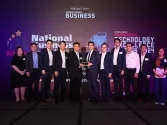
Solar to dominate Asia’s renewable energy future
By Craig FroomeRecent trends within the PV industry have seen a massive increase in the number of module manufacturers within the Asian region. This will set the scene for the next few years where we can expect to see a move away from small roof-top PV systems to the deployment of large-scale commercial and industrial arrays. Historically, in most countries, such as Australia, the roll-out of PV has been dominated by domestic roof-top installations. For a country that has one of the greater levels of solar insolation, the deployment of solar as an energy source is small by world standards. Currently the largest PV flat-panel array is only 1.22MW located in Brisbane at The University of Queensland (UQ), which was designed primarily for research purposes. Whilst the Government has committed support for two large-scale projects and a number of other larger arrays are planned, most are still relatively small compared to those already established within Europe.
The trend of these small-scale commercial and industrial arrays looks like continuing through Asia with the Indian Ministry of New and Renewable Energy recently announcing incentives for the first 100MW of grid connected PV. The Minister responsible has called for an action plan that will look at both domestic and commercial arrays with 78 projects totalling 98MW having already been selected. This would place the average array at a similar size to that which has been deployed at UQ and outside of the domestic size installation. These projects have come about due to the reducing cost of solar technologies compared to other renewable electricity generation options and the ability to scale projects to available space.
Looking at China, if they were to follow the IEA Solar PV Roadmap using the global penetration levels as an indicator, they would be required to have 60GW of installed capacity by 2020 and 270GW by 2030. There is nothing to indicate that China will not exceed these levels (which are still less than 5% of total installed generation capacity).
It wasn’t that long ago that the market was hoping to achieve a US$4/watt module cost, a price barrier that has well and truly been smashed. Modules have recently been selling for less than US$1.00 per watt with the US Government now targeting manufacturing costs of US$0.50/watt. Whilst this may take some time to achieve, it will keep the focus on PV as the renewable energy technology of choice for many policy makers.
Whilst it is good to have these aspirational goals, they must be balanced with the ability of the industry to be sustainable well into the future. There have been a number of well documented failures in the US and with decisions such as that taken by international giant BP to close its PV business; the long-term future of the industry must now be a major consideration. BP Solar’s CEO, Mike Petrucci was quoted in UK’s Guardian as stating that the decision to close the PV business was on the basis that it can no longer “sustain long-term returns for the company”. There will be ramifications in Asia, particularly for India, due to the BP Solar joint venture with Tata Power being in the top three domestic manufacturers. Whilst Tata Power has undertaken to continue operations, licensing agreements for use of the BP technology will have a finite life.
Like much of Australia, many parts of Asia are in an ideal position for solar energy generation with over 300 sunny days per year. Similarly, whilst Europe and the United States have dominated the PV manufacturing industry, Asia has developed a strong solar energy industry with a PV manufacturing capacity which can more than meet local demand as well as create a significant export industry to the traditional markets.
As we now move towards a greener economy, solar energy will continue to dominate the renewable energy landscape, particularly given the regional manufacturing capacity and declining module prices. Whilst there are still issues surrounding intermittency which will be overcome as storage technologies mature, current penetration levels will see continued growth in the photovoltaic sector. Whilst significant advances are being made in a number of renewable energy technologies, it is the mature technologies such as solar PV that will dominate the market in the foreseeable future.









![Cross Domain [Manu + SBR + ABF + ABR + FMCG + HBR + ]](https://cmg-qa.s3.ap-southeast-1.amazonaws.com/s3fs-public/styles/exclusive_featured_article/public/2025-01/earth-3537401_1920_4.jpg.webp?itok=WaRpTJwE)
![Cross Domain [SBR + ABR]](https://cmg-qa.s3.ap-southeast-1.amazonaws.com/s3fs-public/styles/exclusive_featured_article/public/2025-01/pexels-jahoo-867092-2_1.jpg.webp?itok=o7MUL1oO)









 Advertise
Advertise


